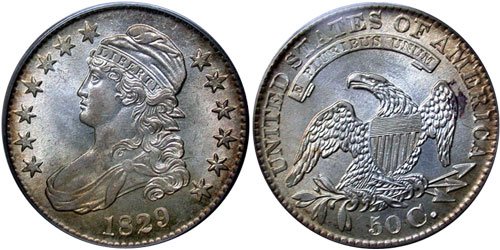Guide to U.S. Capped Bust Half Dollars
The Capped Bust Half Dollar was introduced in 1807 as the third series for the denomination. A similar design would later be adopted for the dime in 1809, the quarter in 1815, and finally the half dime in 1829. Production for the half dollar series would be relatively high, with mintages usually extending into the millions. During this time period, silver dollars were not produced, making the half dollar the coin of choice for silver depositors. For nearly every issue of the series, a number of major varieties exist, which carry different degrees of rarity. These die varieties are heavily collected and include overdates, numbers and lettering differences, and star sizes.

The designer of the Capped Bust Half Dollar was John Reich, a German who came to the United States in the early 19th century. He had been recommended by President Thomas Jefferson for the position of Assistant Engraver in 1801, however he would not take the position until 1807. Robert Scot, Chief Engraver and designer of most of the early United States coins, had initially refused an assistant. Reich was eventually hired when Scot’s health and eyesight began to decline. One of Reich’s first tasks was to create new designs for circulating coinage.
The obverse of Reich’s design for the half dollar features the bust of Liberty, facing left. She is wearing a cap, which is referred to as a Phrygian or Freedom Cap, a symbol popular during the American Revolutionary War. Liberty’s slightly curled hair flows downwards and a small part of her dress can be seen just below the neck. There are seven stars to the left and six to the right, representing the original thirteen states in the Union. Liberty’s headband carries the inscription LIBERTY, and the date is found beneath the portrait.
The reverse design features a bald eagle with its wings spread and a shield over its breast. The eagle’s talons grasp a bundle of arrows and an olive branch. The inscription UNITED STATES OF AMERICA appears above, and a scroll includes the motto E PLURIBUS UNUM. The denomination, expressed as “50 C.” is placed below the eagle. The denomination was also indicated on the edge lettering as FIFTY CENTS OR HALF A DOLLAR.

The design and specifications for the series were modified in 1836, coinciding with the introduction of steam powered presses. The weight and diameter of the half dollar were reduced, with a reeded edge used in place of the previous lettered edge. Design modifications were performed by Christian Gobrecht resulting in subtle changes to the appearance of Liberty, the details of the eagle, and the lettering. More notably, the obverse would have the stars realigned as six to the left and seven to the right, while the reverse would see the removal of the scroll with the motto E PLURIBUS UNUM. Finally, the denomination was altered to read “50 CENTS” from 1836 to 1837 and “HALF DOL.” from 1838 until the conclusion of the series in 1839.

